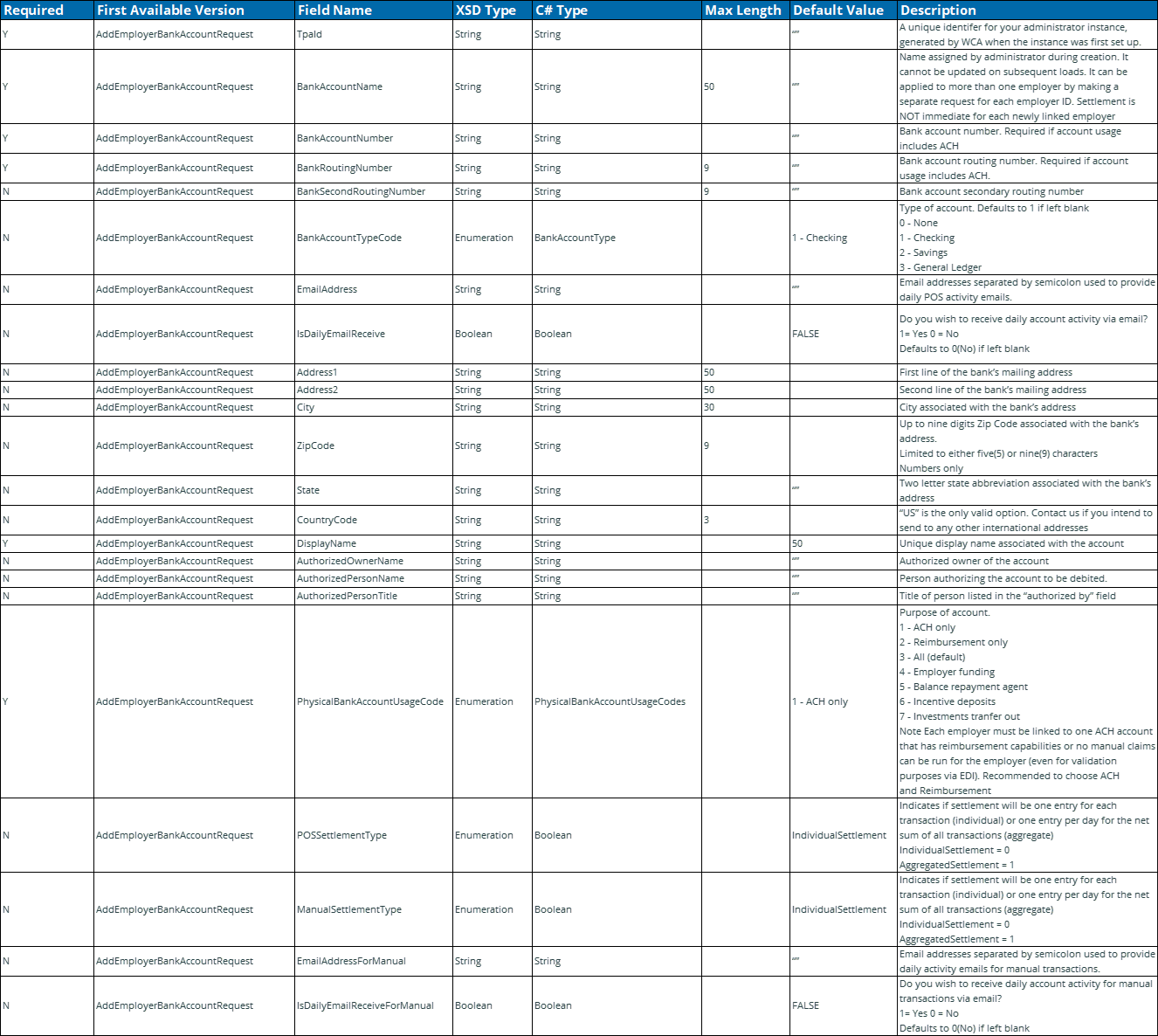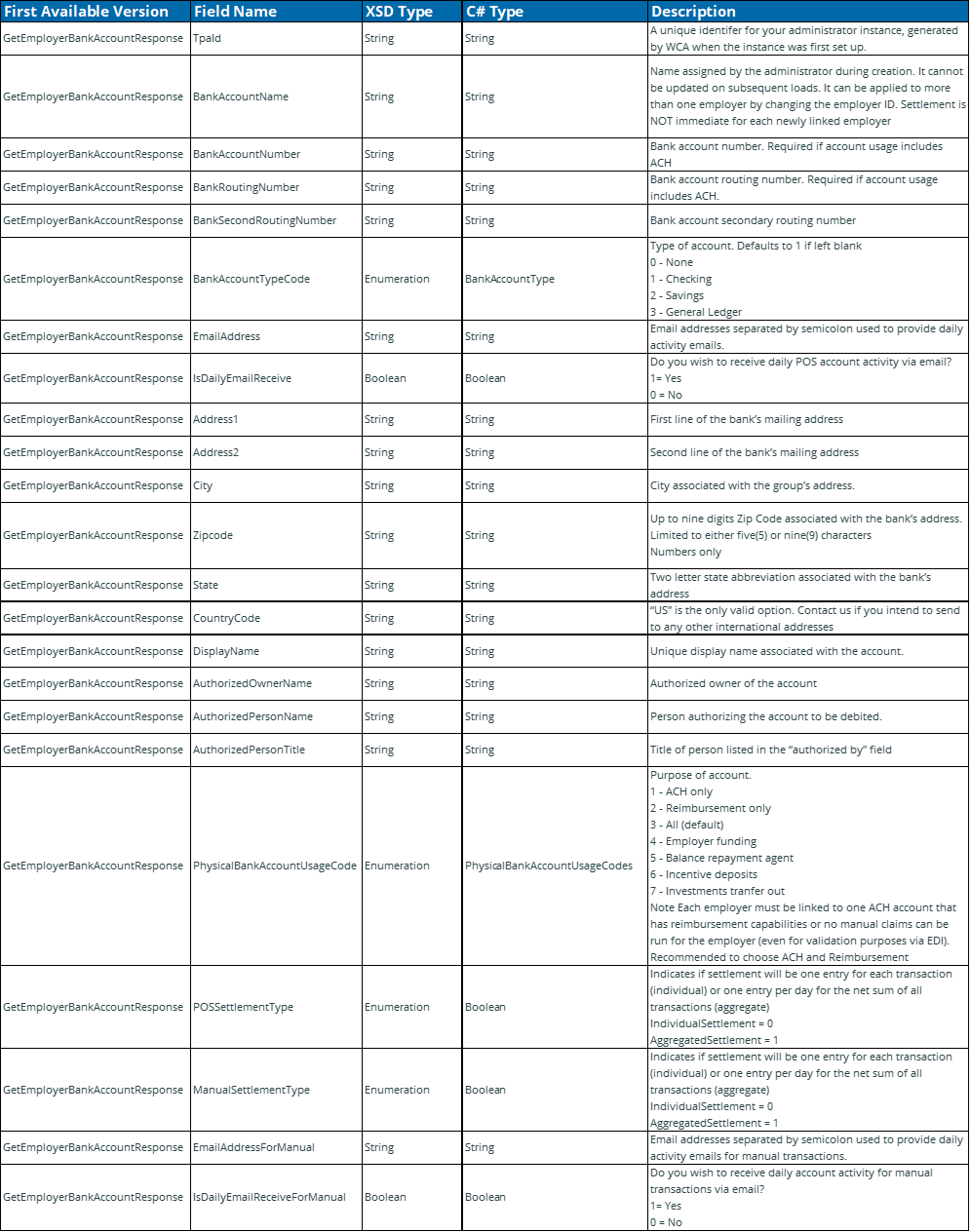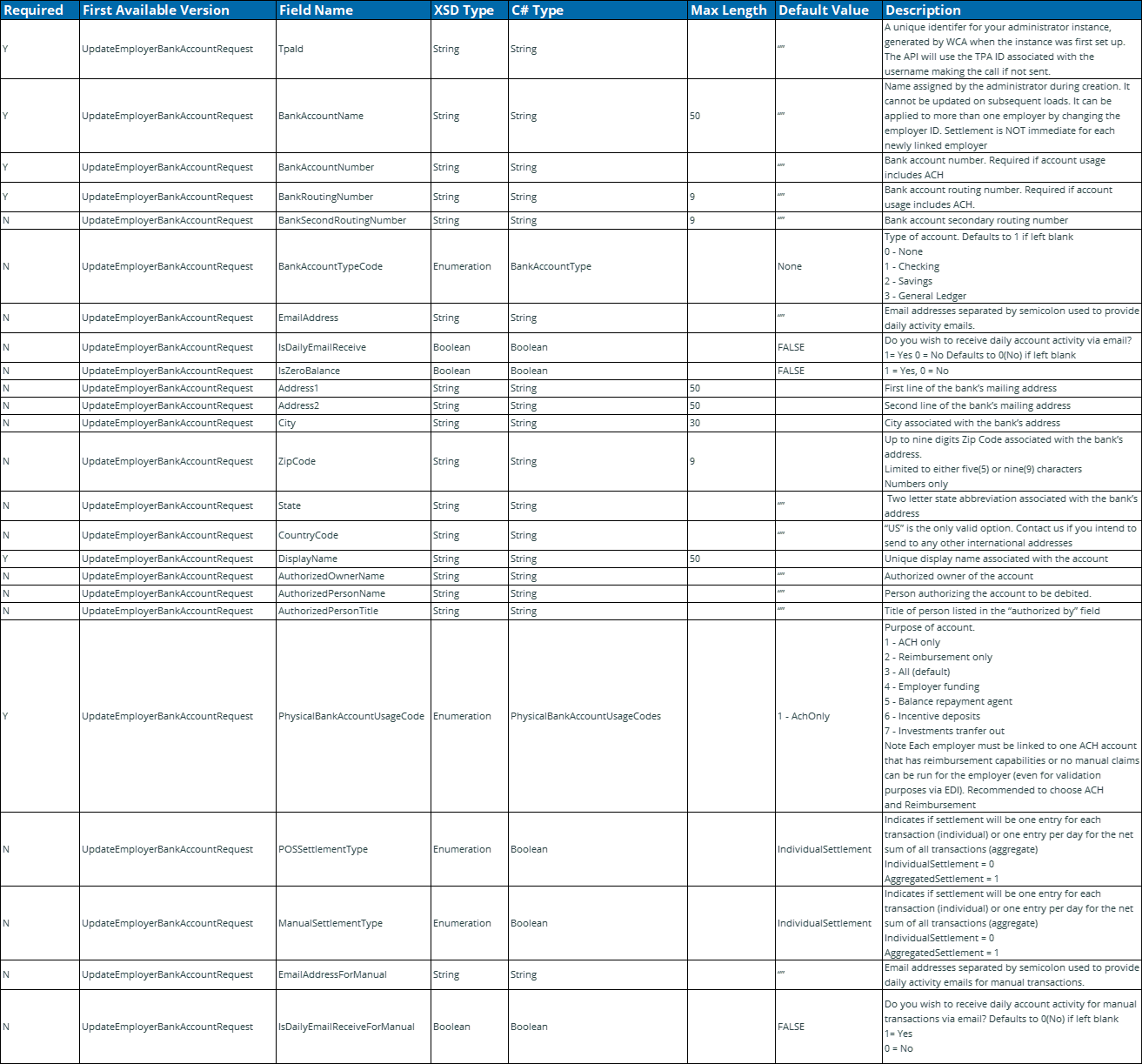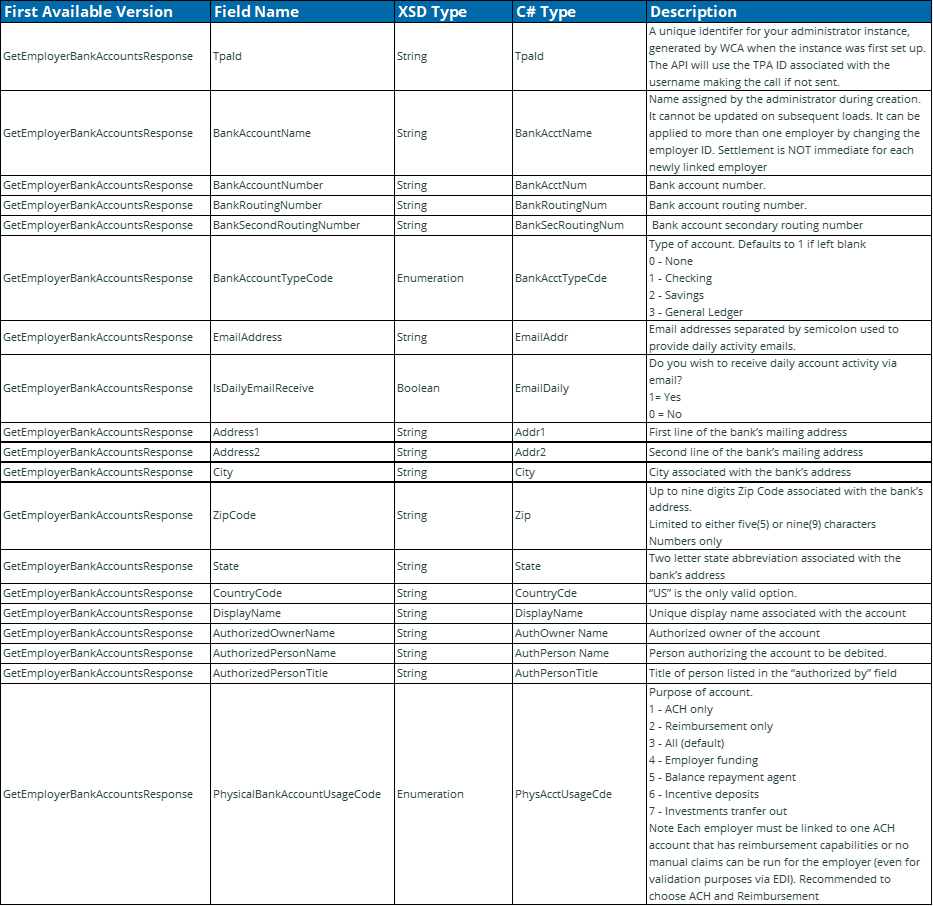
Employer Bank Account API | Administrative - SOAP
The Employer Bank Account Service provides client’s employer bank account functionalities such as reading, adding, and updating employers’ bank account information.
Service Web Methods
The following is a list of methods that is provided by the Employer Bank Account Service
AddEmployerBankAccount – used to add employer bank account information.
GetEmployerBankAccount – used to retrieve employer bank account information.
GetEmployerBankAccounts – used to retrieve employer bank accounts information.
UpdateEmployerBankAccount – used to update an employer’s demographic information. The employer must already exist.
AddEmployerFundingBankAccount – used to add an employer funding bank account.
UpdateEmployerFundingBankAccount – used to update an employer funding bank account.
GetEmployerFundingBankAccount – used to retrieve a list of employer funding bank accounts.
Service Assumptions/Business Rules
The Employer Bank Account Service makes the following assumptions as well as enforce the following business rules.
Clients shall conform to the WS-I specifications unless otherwise agreed upon by Alegeus Technologies and the administrator.
Clients shall format SOAP messages in a Document/Literal format over HTTPS.
Clients shall have already created a valid user ID and password.
Clients shall have a valid session ID after being authenticated by the system. The session ID needs to be passed in the proper manner as described in the Account Manager Service Guide.
If the administrator uses the same user ID and password for all of their clients, the administrator is responsible for managing the security of the data.
Clients should validate data before submitting a request to this Service. This facilitates better performance and accurate processing on both systems.
Clients shall not attempt to use this service for batch processing of large amounts of data. The service is designed for synchronous calls that send or retrieve small chunks of data. If batch processing is required, then the EDI process should be used.
If any method fails, the service returns a SOAP fault describing the problem.
AddEmployerBankAccount
This method is used to add an employer’s bank account information to the system.
History
The AddEmployerBankAccount methods are listed below:
Request Message
AddEmployerBankAccountRequest
Response Message
AddEmployerBankAccountResponse
AddEmployerBankAccount Request/Response Messages
The AddEmployerBankAccount method requires the following request and response messages (input and output data).
The table below includes the following request message:
AddEmployerBankAccountRequest

Response Message: Empty Message
Example of an AddEmployerBankAccount SOAP request message
<?xml version="1.0" encoding="utf-8"?>
<soap:Envelope xmlns:xsi="http://www.w3.org/2001/XMLSchema-instance" xmlns:xsd="http://www.w3.org/2001/XMLSchema" xmlns:soap="http://schemas.xmlsoap.org/soap/envelope/">
<soap:Header>
<MBISessionHeader xmlns="http://www.medibank.com/MBIWebServices/SoapHeader/">
<MBISessionID>123skasdx1324jkfdsafk</MBISessionID>
</MBISessionHeader>
</soap:Header>
<soap:Body>
<AddEmployerBankAccount
xmlns="http://www.medibank.com/MBIWebServices/EmployerBankAccount/Messages/EmployerBankAccount/Request/2004/06/">
<addEmployerBankAccountRequest>
<TpaId>1POINT</TpaId>
<BankAccountName>0037308343 Account</BankAccountName>
<BankAccountNumber>0037308343</BankAccountNumber>
<BankRoutingNumber>064000017</BankRoutingNumber>
<BankSecondRoutingNumber>064000019</BankSecondRoutingNumber>
<BankAccountTypeCode xmlns="http://www.medibank.com/MBIWebServices/Enums/">Checking</BankAccountTypeCode>
<EmailAddress>test@test.com</EmailAddress>
<IsDailyEmailReceive>True</IsDailyEmailReceive>
<Address1>293 Turnpike road</Address1>
<Address2>Apt# 222</Address2>
<City>Westborough</City>
<ZipCode>01581</ZipCode>
<State>MA</State>
<CountryCode>US</CountryCode>
<DisplayName>0037308343 Account</DisplayName>
<AuthorizedOwnerName>TestOwner</AuthorizedOwnerName>
<AuthorizedPersonName>Test</AuthorizedPersonName>
<AuthorizedPersonTitle>TPA</AuthorizedPersonTitle>
<PhysicalBankAccountUsageCode>1</PhysicalBankAccountUsageCode>
</addEmployerBankAccountRequest>
</AddEmployerBankAccount>
</soap:Body>
</soap:Envelope>
Example of an AddEmployerBankAccount SOAP response message
<?xml version="1.0" encoding="utf-8"?><soap:Envelope xmlns:xsi="http://www.w3.org/2001/XMLSchema-instance" xmlns:xsd="http://www.w3.org/2001/XMLSchema" xmlns:soap="http://schemas.xmlsoap.org/soap/envelope/"> <soap:Header>
<MBIMessageIdHeader xmlns="http://www.medibank.com/MBIWebServices/SoapHeader/">
<MessageId>string</MessageId>
</MBIMessageIdHeader>
</soap:Header>
<soap:Body>
<AddEmployerBankAccountResponse xmlns="http://www.medibank.com/MBIWebServices/EmployerBankAccount/Messages/EmployerBankAccount/Response/2004/06/">
<AddEmployerBankAccountResult />
</AddEmployerBankAccountResponse>
</soap:Body>
</soap:Envelope>
Example Client Code
The following is an example of the client code (using a .NET proxy class for accessing the service) used when calling the AddEmployerBankAccount web method.
try
{
// Create the session SOAP header in order to pass the Employer Bank Account
// Service the client’s current session id.
mbiSessionHeader = new EmployerBankAccountServiceNameSpace.MBISessionHeader();
// Create proxy object for the service
proxy = new EmployerBankAccountServiceNameSpace.EmployerBankAccountService();
// Create request message for method call (input parameters) request = new EmployerBankAccountServiceNameSpace.AddEmployerBankAccount
request();
// Set the input parameters
request.TpaId = txtTpaId.Text;
request.BankAccountName = txtBankAccountName.Text;
request.BankAccountNumber = txtBankAccountNumber.Text;
request.BankRoutingNumber = txtBankRoutingNumber.Text;
request.BankSecondRoutingNumber = txtBankSecRoutingNumber.Text;
request.BankAccountTypeCode = txtBankAccountTypeCode.Text;
request.EmailAddress = txtEmailAddr.Text;
request.IsDailyEmailReceive = Convert.ToBoolean(txtIsDailyEmail.Text); request.Address1 = txtAddress1.Text;
request.Address2 = txtAddress2.Text;
request.City = txtCity.Text; request.ZipCode = txtZipCode.Text;
request.State = txtState.Text;
request.CountryCode = txtCountryCode.Text;
request.DisplayName = txtDisplayName.Text;
request.AuthorizedOwnerName = txtAuthOwnerName.Text;
request.AuthorizedPersonName = txtAuthPersonName.Text;
request.AuthorizedPersonTitle = txtAuthPersonTitle.Text;
request.PhysicalBankAccountUsageCode = Convert.ToInt16(txtPhysBankAcctUsageCde.Text);
// session ID returned from login method
mbiSessionHeader.MBISessionID = _sessionId.Text;
proxy.MBISessionHeaderValue = mbiSessionHeader;
// Call the method
response = proxy.AddEmployerBankAccount(request);
MessageBox.Show("Finished.");
}
catch(SoapException se)
{
// perform needed operations
}
catch(Exception ex)
{
// perform needed operations
}
GetEmployerBankAccount
This method is used to retrieve employer bank account information from the system.
History
The GetEmployerBankAccount methods are listed below:
Request Message
GetEmployerBankAccountRequest
Response Message
GetEmployerBankAccountResponse
GetEmployerBankAccount Request/Response Messages
The GetEmployerBankAccount method requires the following request and response messages (input and output data).
The table below includes the following request message: GetEmployerBankAccountRequest
GetEmployerBankAccountRequest

The table below includes the following response message:
GetEmployerBankAccountResponse

Example of a GetEmployerBankAccount SOAP request message
<?xml version="1.0" encoding="utf-8"?>
<soap:Envelope xmlns:xsi="http://www.w3.org/2001/XMLSchema-instance"
xmlns:xsd="http://www.w3.org/2001/XMLSchema" xmlns:soap="http://schemas.xmlsoap.org/soap/envelope/">
<soap:Header>
<MBISessionHeader xmlns="http://www.medibank.com/MBIWebServices/SoapHeader/">
<MBISessionID>123skasdx1324jkfdsafk </MBISessionID>
</MBISessionHeader>
</soap:Header>
<soap:Body>
<GetEmployerBankAccount
xmlns="http://www.medibank.com/MBIWebServices/EmployerBankAccount/Messages/EmployerBankAccount/Request/2004/06/">
<getEmployerBankAccountRequest>
<TpaId>1POINT</TpaId>
<DisplayName>0037308343 Account</DisplayName>
</getEmployerBankAccountRequest>
</GetEmployerBankAccount>
</soap:Body>
</soap:Envelope>
Example of a GetEmployerBankAccount SOAP response message
<?xml version="1.0" encoding="utf-8"?><soap:Envelope xmlns:xsi="http://www.w3.org/2001/XMLSchema-instance" xmlns:xsd="http://www.w3.org/2001/XMLSchema" xmlns:soap="http://schemas.xmlsoap.org/soap/envelope/"> <soap:Header>
<MBIMessageIdHeader xmlns="http://www.medibank.com/MBIWebServices/SoapHeader/">
<MessageId>string</MessageId>
</MBIMessageIdHeader>
</soap:Header>
<soap:Body>
<GetEmployerBankAccountResponse xmlns="http://www.medibank.com/MBIWebServices/EmployerBankAccount/Messages/EmployerBankAccount/Response/2004/06/">
<GetEmployerBankAccountResult>
<TpaId>1POINT</TpaId>
<BankAccountName>0037308343 Account</BankAccountName>
<BankAccountNumber>0037308343</BankAccountNumber>
<BankRoutingNumber>064000017</BankRoutingNumber>
<BankSecondRoutingNumber>064000019</BankSecondRoutingNumber>
<BankAccountTypeCode xmlns="http://www.medibank.com/MBIWebServices/Enums/"> Checking </BankAccountTypeCode>
<EmailAddress>test@test.com</EmailAddress>
<IsDailyEmailReceive>True</IsDailyEmailReceive>
<Address1>293 Turnpike road</Address1>
<Address2>Apt# 222</Address2>
<City>Westborough</City>
<ZipCode>01581</ZipCode>
<State>MA</State>
<CountryCode>US</CountryCode>
<DisplayName>0037308343 Account</DisplayName>
<AuthorizedOwnerName>TestOwner</AuthorizedOwnerName>
<AuthorizedPersonName>Test</AuthorizedPersonName>
<AuthorizedPersonTitle>TPA</AuthorizedPersonTitle>
<PhysicalBankAccountUsageCode>1</PhysicalBankAccountUsageCode>
</GetEmployerBankAccountResult>
</GetEmployerBankAccountResponse>
</soap:Body>
</soap:Envelope>
Example Client Code
The following is an example of the client code (using a .NET proxy class to connect to the service) used when calling the GetEmployerBankAccount method.
try
{
// Create the session SOAP header in order to pass the Service // the client’s current session id.
mbiSessionHeader = new EmployerBankAccountServiceNameSpace.MBISessionHeader();
// Create proxy object for the service
proxy = new EmployerBankAccountServiceNameSpace.EmployerBankAccountService();
// Create request message for method call (input parameters)
request = new EmployerBankAccountServiceNameSpace.GetEmployerBankAccountRequest();
// Set the input parameters
request.DisplayName = _txtDisplayName.Text; request.TpaId = _tpaId.Text;
// session ID returned from logon method mbiSessionHeader.MBISessionID = _sessionId.Text; proxy.MBISessionHeaderValue = mbiSessionHeader;
response = proxy.GetEmployerBankAccount(request);
}
catch(SoapException se)
{
// perform needed operations
}
catch(Exception ex)
{
// perform needed operations
}
UpdateEmployerBankAccount
This method is used to update employer bank account information for an account that already exists.
History
The UpdateEmployerBankAccount methods are listed below:
Request Message
UpdateEmployerBankAccountRequest
Response Message
UpdateEmployerBankAccountResponse
UpdateEmployerBankAccount Request/Response Messages
The UpdateEmployerBankAccount method requires the following request and response messages (input and output data).
The table below includes the following request message:
UpdateEmployerBankAccountRequest

Response Message: Empty Message
Example of an UpdateEmployerBankAccount SOAP request message
<?xml version="1.0" encoding="utf-8"?>
<soap:Envelope xmlns:xsi="http://www.w3.org/2001/XMLSchema-instance" xmlns:xsd="http://www.w3.org/2001/XMLSchema" xmlns:soap="http://schemas.xmlsoap.org/soap/envelope/">
<soap:Header>
<MBISessionHeader xmlns="http://www.medibank.com/MBIWebServices/SoapHeader/">
<MBISessionID>string</MBISessionID>
</MBISessionHeader>
</soap:Header>
<soap:Body>
<UpdateEmployerBankAccount xmlns="http://www.medibank.com/MBIWebServices/EmployerBankAccount/Messages/EmployerBankAccount/Request/2004/06/
">
<updateEmployerBankAccountRequest>
<TpaId>1POINT</TpaId>
<BankAccountName>0037308343 Account</BankAccountName>
<BankAccountNumber>0037308343</BankAccountNumber>
<BankRoutingNumber>064000017</BankRoutingNumber>
<BankSecondRoutingNumber>064000019</BankSecondRoutingNumber>
<BankAccountTypeCode
xmlns="http://www.medibank.com/MBIWebServices/Enums/">Checking</BankAccountTypeCode>
<EmailAddress>test@test.com</EmailAddress>
<IsDailyEmailReceive>True</IsDailyEmailReceive>
<Address1>293 Turnpike road</Address1>
<Address2>Apt# 222</Address2>
<City>Westborough</City>
<ZipCode>01581</ZipCode>
<State>MA</State>
<CountryCode>US</CountryCode>
<DisplayName>0037308343 Account</DisplayName>
<AuthorizedOwnerName>TestOwner</AuthorizedOwnerName>
<AuthorizedPersonName>Test</AuthorizedPersonName>
<AuthorizedPersonTitle>TPA</AuthorizedPersonTitle>
<PhysicalBankAccountUsageCode>1</PhysicalBankAccountUsageCode>
</updateEmployerBankAccountRequest>
</UpdateEmployerBankAccount>
</soap:Body>
</soap:Envelope>
Example of an UpdateEmployerBankAccount SOAP response message
<?xml version="1.0" encoding="utf-8"?>
<soap:Envelope xmlns:xsi="http://www.w3.org/2001/XMLSchema-instance" xmlns:xsd="http://www.w3.org/2001/XMLSchema" xmlns:soap="http://schemas.xmlsoap.org/soap/envelope/">
<soap:Header>
<MBIMessageIdHeader xmlns="http://www.medibank.com/MBIWebServices/SoapHeader/">
<MessageId>string</MessageId>
</MBIMessageIdHeader>
</soap:Header>
<soap:Body>
<UpdateEmployerBankAccountResponse xmlns="http://www.medibank.com/MBIWebServices/EmployerBankAccount/Messages/EmployerBankAccount/Response/2004/0
6/">
<UpdateEmployerBankAccountResult />
</UpdateEmployerBankAccountResponse>
</soap:Body>
</soap:Envelope>
Example Client Code
The following is an example of the client code (using a .NET proxy class for the service) used when calling the UpdateEmployerBankAccount method.
try
{
// Create the session SOAP header in order to pass the Service
// the client’s current session id.
mbiSessionHeader = new EmployerBankAccountServiceNameSpace.MBISessionHeader();
// Create proxy object for the Employer Bank Account service
proxy = new EmployerBankAccountServiceNameSpace.EmployerService();
// Create request message for method call (input parameters)
request = new EmployerBankAccountServiceNameSpace.UpdateEmployerBankAccountRequest();
// Set the input parameters
request.TpaId = txtTpaId.Text;
request.BankAccountName = txtBankAccountName.Text;
request.BankAccountNumber = txtBankAccountNumber.Text;
request.BankRoutingNumber = txtBankRoutingNumber.Text;
request.BankSecondRoutingNumber = txtBankSecRoutingNumber.Text;
request.BankAccountTypeCode = txtBankAccountTypeCode.Text;
request.EmailAddress = txtEmailAddr.Text;
request.IsDailyEmailReceive = Convert.ToBoolean(txtIsDailyEmail.Text);
request.Address1 = txtAddress1.Text;
request.Address2 = txtAddress2.Text;
request.City = txtCity.Text;
request.ZipCode = txtZipCode.Text;
request.State = txtState.Text;
request.CountryCode = txtCountryCode.Text;
request.DisplayName = txtDisplayName.Text;
request.AuthorizedOwnerName = txtAuthOwnerName.Text;
request.AuthorizedPersonName = txtAuthPersonName.Text;
request.AuthorizedPersonTitle = txtAuthPersonTitle.Text;
request.PhysicalBankAccountUsageCode = Convert.ToInt16(txtPhysBankAcctUsageCde.Text);
// session ID returned from login method
mbiSessionHeader.MBISessionID = _sessionId.Text; proxy.MBISessionHeaderValue = mbiSessionHeader;
// Call the method
response = proxy.UpdateEmployerBankAccount(request);
MessageBox.Show("Finished.");
}
catch(SoapException se)
{
// perform needed operations
}
catch(Exception ex)
{
// perform needed operations
}
GetEmployerBankAccounts
This method is used to get a list of an employer’s physical bank accounts.
History
The GetEmployerBankAccounts methods are listed below:
Request Message
GetEmployerBankAccountsRequest
Response Message
GetEmployerBankAccountsResponse
GetEmployerBankAccounts Request/Response Messages
The GetEmployerBankAccounts method requires the following request and response messages (input and output data).
The table below includes the following request message:
GetEmployerBankAccountsRequest

The table below includes the following response message:
GetEmployerBankAccountsResponse

Example of a GetEmployerBankAccounts SOAP request message
<?xml version="1.0" encoding="utf-8" ?>
<soap:Envelope xmlns:soap="http://schemas.xmlsoap.org/soap/envelope/" xmlns:xsi="http://www.w3.org/2001/XMLSchemainstance" xmlns:xsd="http://www.w3.org/2001/XMLSchema">
<soap:Header>
<MBISessionHeader xmlns="http://www.medibank.com/MBIWebServices/SoapHeader/">
<MBISessionID>ry5oonmlujlpsgzxetfxllnj</MBISessionID>
</MBISessionHeader>
</soap:Header>
<soap:Body>
<GetEmployerBankAccounts xmlns="http://www.medibank.com/MBIWebServices/EmployerBankAccount/Messages/EmployerBankAccount/Request/2004/06/">
<getEmployerBankAccountsRequest>
<TpaId>T00202</TpaId>
<BankName>Cynthia</BankName>
</getEmployerBankAccountsRequest>
</GetEmployerBankAccounts>
</soap:Body>
</soap:Envelope>
Example of a GetEmployerBankAccounts SOAP response message
<?xml version="1.0" encoding="utf-8" ?>
<soap:Envelope xmlns:soap="http://schemas.xmlsoap.org/soap/envelope/" xmlns:xsi="http://www.w3.org/2001/XMLSchemainstance" xmlns:xsd="http://www.w3.org/2001/XMLSchema">
<soap:Header>
<MBIMessageIdHeader xmlns="http://www.medibank.com/MBIWebServices/SoapHeader/" />
</soap:Header>
<soap:Body>
<GetEmployerBankAccountsResponse
xmlns="http://www.medibank.com/MBIWebServices/EmployerBankAccount/Messages/EmployerBankAccount/Response/2004/06/">
<GetEmployerBankAccountsResult>
<GetEmployerBankAccountsResponse>
<TpaId>T00202</TpaId>
<BankAccountName>Cynthia</BankAccountName>
<BankAccountNumber>234525435</BankAccountNumber>
<BankRoutingNumber>053200983</BankRoutingNumber>
<BankSecondRoutingNumber />
<BankAccountTypeCode
xmlns="http://www.medibank.com/MBIWebServices/Enums/">Checking</BankAccountTypeCode>
<EmailAddress />
<IsDailyEmailReceive>false</IsDailyEmailReceive>
<Address1/>
<Address2/>
<City/>
<ZipCode/>
<State/>
<CountryCode>US</CountryCode>
<DisplayName>Cynthia</DisplayName>
<AuthorizedOwnerName/>
<AuthorizedPersonName>J GOPALSAMY</AuthorizedPersonName>
<AuthorizedPersonTitle/>
<PhysicalBankAccountUsageCode
xmlns="http://www.medibank.com/MBIWebServices/Enums/">AchAndReimbursement</PhysicalBankAccountUsageCode> </GetEmployerBankAccountsResponse>
</GetEmployerBankAccountsResult>
</GetEmployerBankAccountsResponse>
</soap:Body>
</soap:Envelope>
Example Client Code
The following is an example of the client code (using a .NET proxy class to connect to the service) used when calling the GetEmployerBankAccounts method.
try
{
// Create the session SOAP header in order to pass the Service
// the client’s current session id.
mbiSessionHeader = new EmployerBankAccountServiceNameSpace.MBISessionHeader();
// Create proxy object for the Employer Bank Account service
proxy = new EmployerBankAccountServiceNameSpace.EmployerBankAccountService();
// Create request message for method call (input parameters)
request = new EmployerBankAccountServiceNameSpace.GetEmployerBankAccountsRequest();
// Set the input parameters
request.TpaId = txtTpaId.Text; request.BankName = txtBankName.Text;
// session ID returned from logon method
mbiSessionHeader.MBISessionID = _sessionId.Text;
proxy.MBISessionHeaderValue = mbiSessionHeader;
response = proxy.GetEmployerBankAccounts(request);
MessageBox.Show("Finished.");
}
catch(SoapException se)
{
// perform needed operations
}
catch(Exception ex)
{
// perform needed operations
}
AddEmployerFundingBankAccount
This method is used to add an employer funding bank account.
History
The AddEmployerFundingBankAccount methods are listed below:
Request Messages
AddEmployerFundingBankAccountRequest
Response Messages
AddEmployerFundingBankAccountResponse
AddEmployerFundingBankAccount Request/Response Messages
The AddEmployerFundingBankAccount method requires the following request and response messages (input and output data).
The table below includes the following request messages:
AddEmployerFundingBankAccountRequest

Response Message: Request submitted successfully.
Example of an AddEmployerFundingBankAccount SOAP request message
<soapenv:Envelope xmlns:soapenv="http://schemas.xmlsoap.org/soap/envelope/" xmlns:mbi="http://schemas.datacontract.org/2004/07/MBI.WebServices.Wcf.Headers" xmlns:v1="http://bensoft.metavante.com/WebServices/Contracts/EmployerBankAccount/2015/10/V1" xmlns:ns="http://bensoft.metavante.com/WebServices/Messages/EmployerBankAccount/Request/2015/10/">
<soapenv:Header>
<mbiSessionHeader>
<!--Optional:-->
<mbi:MBISessionID>uetukcmzzzzzzzpgoiipqe20</mbi:MBISessionID>
</mbiSessionHeader>
</soapenv:Header>
<soapenv:Body>
<v1:AddEmployerFundingBankAccount>
<!--Optional:-->
<v1:request>
<ns:AccountName>TESTACCOUNT</ns:AccountName>
<ns:BankAccountNumber>2626265115</ns:BankAccountNumber>
<ns:BankRoutingNumber>124101128</ns:BankRoutingNumber>
<ns:FICountryCode>US</ns:FICountryCode>
<ns:FIState>UT</ns:FIState>
<ns:TpaId>T99999</ns:TpaId>
</v1:request>
</v1:AddEmployerFundingBankAccount>
</soapenv:Body>
</soapenv:Envelope>
Example of an AddEmployerFundingBankAccount SOAP response message:
<s:Envelope xmlns:s="http://schemas.xmlsoap.org/soap/envelope/">
<s:Header>
<MBIMessageIdHeader xmlns="http://bensoft.metavante.com/WebServices/SoapHeader/">
<MessageId>urn:uuid:9c4e6f72-0915-4940-zzzz-532c378ad03c</MessageId>
</MBIMessageIdHeader>
</s:Header>
<s:Body>
<AddEmployerFundingBankAccountResponse xmlns="http://bensoft.metavante.com/WebServices/Contracts/EmployerBankAccount/2015/10/V1">
<AddEmployerFundingBankAccountResult xmlns:a="http://bensoft.metavante.com/WebServices/Messages/EmployerBankAccount/Response/2015/10/"
xmlns:i="http://www.w3.org/2001/XMLSchema-instance">
<a:ErrorCode>0</a:ErrorCode>
<a:ErrorDescription>Request submitted successfully.</a:ErrorDescription>
</AddEmployerFundingBankAccountResult>
</AddEmployerFundingBankAccountResponse>
</s:Body>
</s:Envelope>
Example Client Code
The following is an example of the client code (using a .NET proxy class for the service) used when calling the AddEmployerFundingBankAccount method.
try
{
// Create the session SOAP header in order to pass the Service // the client’s current session id.
mbiSessionHeader = new EmployerBankAccountServiceNameSpace.MBISessionHeader();
// Create proxy object for the service proxy = new EmployerBankAccountServiceNameSpace.EmployerBankAccountService();
// Create request message for method call (input parameters) request = new EmployerBankAccountServiceNameSpace.AddEmployerFundingBankAccount();
// Set the input parameters request.TpaId = _tpaId.Text; request.AccountName = _employerId.Text; request.BankAccountNumber = _AccountName.Text; request.BankRoutingNumber = _BankRoutingNumber.Text; request.FICountryCode = _BankRoutingNumber.Text; request.FIState = _BankRoutingNumber.Text;
// session ID returned from logon method mbiSessionHeader.MBISessionID = _sessionId.Text; proxy.MBISessionHeaderValue = mbiSessionHeader;
response = proxy.AddEmployerFundingBankAccount(request);
}
catch(SoapException se)
{
// perform needed operations\
}
catch(Exception ex)
{
// perform needed operations
}
UpdateEmployerFundingBankAccount
This method is used to update an employer funding bank account.
History
The UpdateEmployerFundingBankAccount methods are listed below:
Request Messages
UpdateEmployerFundingBankAccountRequest
Response Messages
UpdateEmployerFundingBankAccountResponse
UpdateEmployerFundingBankAccount Request/Response Messages
The UpdateEmployerFundingBankAccount method requires the following request and response messages (input and output data).
The table below includes the following request messages:
UpdateEmployerFundingBankAccountRequest

Response Message: Request submitted successfully.
Example of an UpdateEmployerFundingBankAccount SOAP request message
<soapenv:Envelope xmlns:soapenv="http://schemas.xmlsoap.org/soap/envelope/" xmlns:mbi="http://schemas.datacontract.org/2004/07/MBI.WebServices.Wcf.Headers" xmlns:v1="http://bensoft.metavante.com/WebServices/Contracts/EmployerBankAccount/2015/10/V1"
xmlns:ns="http://bensoft.metavante.com/WebServices/Messages/EmployerBankAccount/Request/2015/10/">
<soapenv:Header>
<mbiSessionHeader>
<!--Optional:-->
<mbi:MBISessionID>uetukcmzzzzzzzpgoiipqe20</mbi:MBISessionID>
</mbiSessionHeader>
</soapenv:Header>
<soapenv:Body>
<v1:UpdateEmployerFundingBankAccount>
<!--Optional:-->
<v1:request>
<ns:AccountName>TESTACCOUNT</ns:AccountName>
<ns:BankAccountNumber>2626265115</ns:BankAccountNumber>
<ns:BankRoutingNumber>124101128</ns:BankRoutingNumber>
<ns:FICountryCode>US</ns:FICountryCode>
<ns:FIState>UT</ns:FIState>
<ns:TpaId>T99999</ns:TpaId>
</v1:request>
</v1:UpdateEmployerFundingBankAccount>
</soapenv:Body>
</soapenv:Envelope>
Example of an UpdateEmployerFundingBankAccount SOAP response message
<s:Envelope xmlns:s="http://schemas.xmlsoap.org/soap/envelope/">
<s:Header>
<MBIMessageIdHeader xmlns="http://bensoft.metavante.com/WebServices/SoapHeader/">
<MessageId>urn:uuid:9c4e6f72-0915-4940-zzzz-532c378ad03c</MessageId>
</MBIMessageIdHeader>
</s:Header>
<s:Body>
<UpdateEmployerFundingBankAccountResponse
xmlns="http://bensoft.metavante.com/WebServices/Contracts/EmployerBankAccount/2015/10/V1">
<UpdateEmployerFundingBankAccountResult
xmlns:a="http://bensoft.metavante.com/WebServices/Messages/EmployerBankAccount/Response/2015/10/"
xmlns:i="http://www.w3.org/2001/XMLSchema-instance">
<a:ErrorCode>0</a:ErrorCode>
<a:ErrorDescription>Request submitted successfully.</a:ErrorDescription>
</UpdateEmployerFundingBankAccountResult>
</UpdateEmployerFundingBankAccountResponse>
</s:Body>
</s:Envelope>
Example Client Code
The following is an example of the client code (using a .NET proxy class for the service) used when calling the UpdateEmployerFundingBankAccount method.
try
{
// Create the session SOAP header in order to pass the Service // the client’s current session id.
mbiSessionHeader = new EmployerBankAccountServiceNameSpace.MBISessionHeader();
// Create proxy object for the service proxy = new EmployerBankAccountServiceNameSpace.EmployerBankAccountService();
// Create request message for method call (input parameters) request = new EmployerBankAccountServiceNameSpace.UpdateEmployerFundingBankAc
ount();
// Set the input parameters
request.TpaId = _tpaId.Text;
request.AccountName = _employerId.Text;
request.BankAccountNumber = _AccountName.Text;
request.BankRoutingNumber = _BankRoutingNumber.Text;
request.FICountryCode = _BankRoutingNumber.Text;
request.FIState = _BankRoutingNumber.Text;
// session ID returned from logon method mbiSessionHeader.MBISessionID = _sessionId.Text; proxy.MBISessionHeaderValue = mbiSessionHeader;
response = proxy.UpdateEmployerFundingBankAccount(request);
}
catch(SoapException se)
{
// perform needed operations
}
catch(Exception ex)
{
// perform needed operations
}
GetEmployerFundingBankAccounts
This method is used to get a list of all employer funding bank accounts.
History
The GetEmployerFundingBankAccounts methods are listed below:
Request Messages
GetEmployerFundingBankAccountsRequest
Response Messages
GetEmployerFundingBankAccountsResponse
GetEmployerFundingBankAccounts Request/Response Messages
The GetEmployerFundingBankAccounts method requires the following request and response messages (input and output data).
The table below includes the following request messages:
GetEmployerFundingBankAccountsRequest

The table below includes the following response messages:
GetEmployerFundingBankAccountsResponse

Example of an GetEmployerFundingBankAccounts SOAP request message
<soapenv:Envelope xmlns:soapenv="http://schemas.xmlsoap.org/soap/envelope/" xmlns:mbi="http://schemas.datacontract.org/2004/07/MBI.WebServices.Wcf.Headers" xmlns:v1="http://bensoft.metavante.com/WebServices/Contracts/EmployerBankAccount/2015/10/V1" xmlns:ns="http://bensoft.metavante.com/WebServices/Messages/EmployerBankAccount/Request/2015/10/">
<soapenv:Header>
<mbiSessionHeader>
<!--Optional:-->
<mbi:MBISessionID>uetukcmzzzzzzzpgoiipqe20</mbi:MBISessionID>
</mbiSessionHeader>
</soapenv:Header>
<soapenv:Body>
<v1:GetEmployerFundingBankAccounts>
<!--Optional:-->
<v1:request>
<!--Optional:-->
<ns:TpaId>T99999</ns:TpaId>
</v1:request>
</v1:GetEmployerFundingBankAccounts>
</soapenv:Body>
</soapenv:Envelope>
Example of an GetEmployerFundingBankAccounts SOAP response message
<s:Envelope xmlns:s="http://schemas.xmlsoap.org/soap/envelope/">
<s:Header>
<MBIMessageIdHeader xmlns="http://bensoft.metavante.com/WebServices/SoapHeader/">
<MessageId>urn:uuid:e760c3c7-c3b0-4781-a46b-6caf86b5df26</MessageId>
</MBIMessageIdHeader>
<mbiWarningsHeader xmlns:i="http://www.w3.org/2001/XMLSchema-instance">
<MBIWarnings i:nil="true" xmlns="http://schemas.datacontract.org/2004/07/MBI.WebServices.Wcf.Headers"/>
</mbiWarningsHeader>
</s:Header> <s:Body>
<GetEmployerFundingBankAccountsResponse
xmlns="http://bensoft.metavante.com/WebServices/Contracts/EmployerBankAccount/2015/10/V1">
<GetEmployerFundingBankAccountsResult
xmlns:a="http://bensoft.metavante.com/WebServices/Messages/EmployerBankAccount/Response/2015/10/"
xmlns:i="http://www.w3.org/2001/XMLSchema-instance">
<a:GetEmployerFundingBankAccountsResponse
<a:AccountName>Board of Trustees</a:AccountName>
<a:AuthorizedOwnerName/>
<a:AuthorizedPersonName>WALT DISNEY</a:AuthorizedPersonName>
<a:AuthorizedPersonTitle/>
<a:BankAccountNumber>64196465464</a:BankAccountNumber>
<a:BankAccountType>Checking</a:BankAccountType>
<a:BankRoutingNumber>000000000</a:BankRoutingNumber>
<a:BankSecondRoutingNumber/>
<a:FIAddress1>1313 Disneyland Dr</a:FIAddress1>
<a:FIAddress2/>
<a:FICity>Anaheim</a:FICity>
<a:FICountryCode>US</a:FICountryCode>
<a:FIState/>CA</a:FIState>
<a:FIZipCode>92802</a:FIZipCode>
<a:FinancialInstitutionName>ACME Bank</a:FinancialInstitutionName>
<a:TpaId>T99999</a:TpaId>
</a:GetEmployerFundingBankAccountsResponse>
Example Client Code
The following is an example of the client code (using a .NET proxy class for the service) used when calling the GetEmployerFundingBankAccounts method.
try
{
// Create the session SOAP header in order to pass the Service
// the client’s current session id.
mbiSessionHeader = new EmployerBankAccountServiceNameSpace.MBISessionHeader();
// Create proxy object for the service proxy = new EmployerBankAccountServiceNameSpace.EmployerBankAccountService();
// Create request message for method call (input parameters)
request = new EmployerBankAccountServiceNameSpace.GetEmployerFundingBankAccounts();
// Set the input parameters request.TpaId = _tpaId.Text;
// session ID returned from logon method mbiSessionHeader.MBISessionID = _sessionId.Text; proxy.MBISessionHeaderValue = mbiSessionHeader;
response = proxy.GetEmployerFundingBankAccounts(request);
}
catch(SoapException se)
{
// perform needed operations
}
catch(Exception ex)
{
// perform needed operations
}
Copyright © 2023 Alegeus Technologies, LLC. All rights reserved. Alegeus, Alegeus Technologies, WealthCare, WealthCare Saver are registered trademarks of Alegeus Technologies, LLC